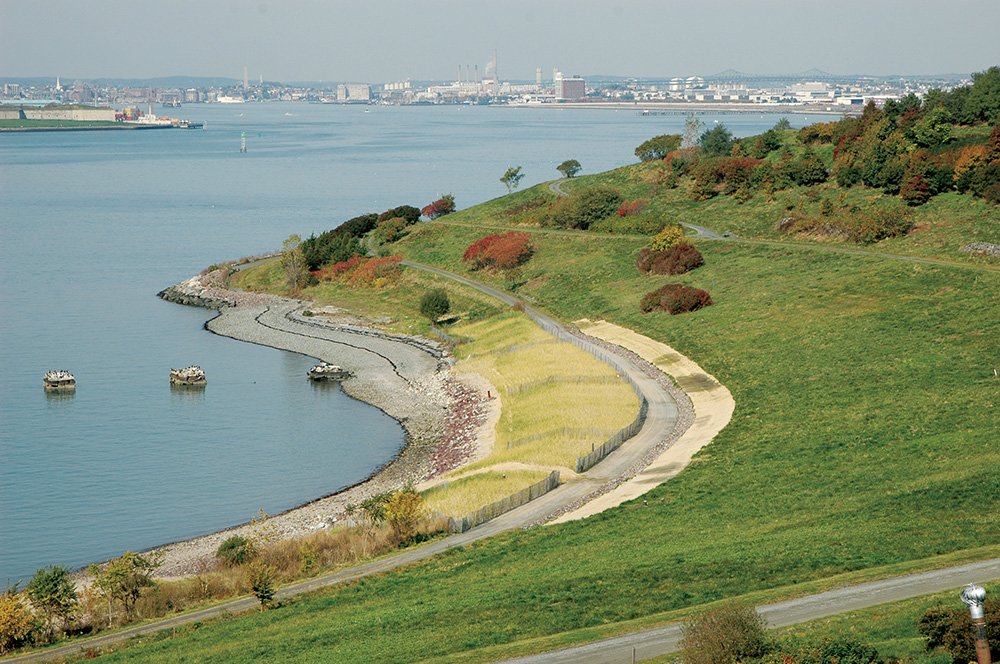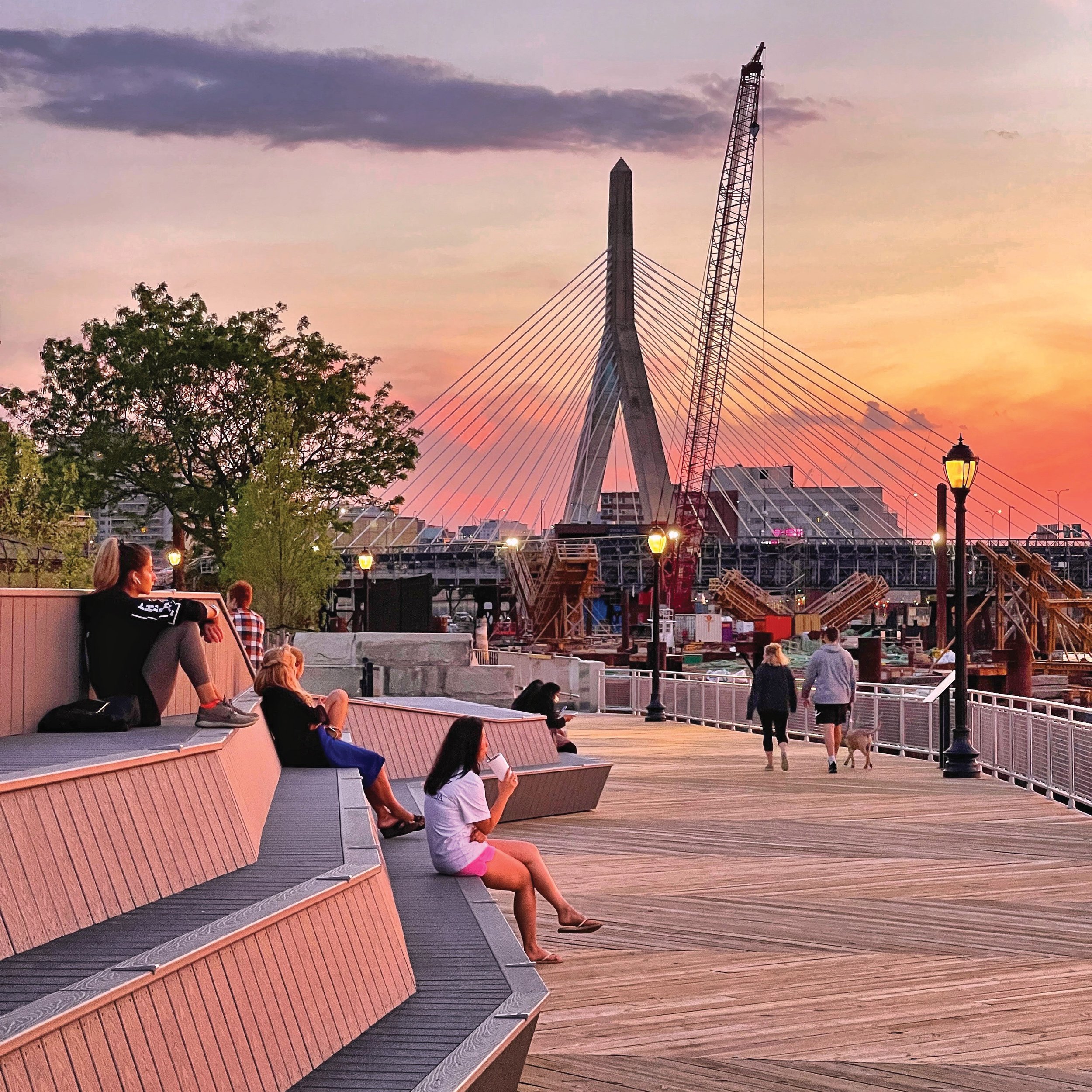Building resilient parks one ingredient at a time
By Cheri Ruane
“Stone Soup” is a European folk story in which hungry strangers, carrying nothing but a cooking pot filled with water and a stone arrive in a town and convince each of the townspeople to share a small amount of their food to make a meal that everyone enjoys. It is a lesson on the value of sharing and the potential synergy borne of collaboration. When building a resilient, public open space, the process is not that different. It often begins with one municipal department and an idea (the cooking pot). Slowly but surely, more departments, agencies, funding sources, stakeholders, and others become invested in what’s possible and bring their contributions to the table.

Getting Started
Parks are a critical infrastructure. Even though parks may not have rate payers like those of water, sewer, and electricity to continuously fund upkeep and capital improvement, they certainly have a huge impact on quality of life. In many communities, parks are often the last remaining publicly owned, undeveloped parcels of land. Urban heat-island effect, storms, and sea-level rise are having steadily increasing impacts on neighborhoods, cities, and towns. Without buildings and pavement, parks hold the greatest opportunity to support climate resilience. When they are renovated, they are well-positioned to expand their infrastructure capacity.
Resilient park projects are often conceived in response to a catastrophic weather event that has had a significant local or regional impact. Documenting these social and financial consequences provides powerful back-up when initiating this important work.
Building Community
The location of these impacts and the network of stakeholders will inform the best capital-improvement strategy. Specific project identification and proponent working groups can evolve concurrently. In fact, in the most successful projects, they inform each other. Often, there is a park or public open space within the general area of influence that can contribute to a mitigation approach. The concept involves connecting with those who will benefit from these improvements (abutters, utilities, residents, etc.) and then expanding the “project community” to include potential funders, non-profit organizations, and advocacy groups. From this constellation of human capital, a working group can be formed.
Funding sources can be found in both predictable and unexpected places. In Massachusetts, the Municipal Vulnerability Preparedness program offers state grant money for municipal resiliency projects. Federal funding through the American Rescue Plan Act and Infrastructure Investment and Jobs Act has also begun to make its way into communities across the country. Private philanthropic foundations are joining in the fight as well to make neighborhoods more resilient. Funding can come from multiple departments, stormwater infrastructure, urban forestry, and recreation, and protection from sea-level rise can often happen in one place, multitasking every dollar spent.
What Makes A Resilient Park?
An interdependent team of experts will be required to understand what is necessary to protect, retreat, or accommodate the impacts of climate change.
Protection can include flood barriers and backflow protectors. Retreating means relocating important features away from areas prone to flooding. Accommodating strategies include creating places that can withstand temporary flooding. Often, all three approaches are utilized to create a resilient public open space. In the movie Mary Poppins, a character is drawing pictures in chalk on a sidewalk that are so realistic that Mary, with her magic umbrella, immerses herself in the scene. Like that character, we must paint a clear picture of what’s possible when communicating a vision. This allows people to imagine for themselves what is possible.
When it comes to resilient parks, beautiful open spaces will support a high level of active and passive recreation that also works to mitigate the impacts of climate change. It is a vision worth getting excited about. Illustrative renderings and legible drawings can communicate that compelling potential in a way that engenders interest and commitment.
These renderings and drawings not only help educate various stakeholders on the desired project outcomes but also allow the project team to collect meaningful feedback. When the public better understands what’s being proposed, it can comment in an informed way. This process of iteration helps build a sense of ownership around the project that will serve parks long into the future. A visual narrative is also effective when aligning permitting and funding agencies early (and often) in the process.

The Tectonics Of Resiliency
Parks with the highest potential for protecting communities from sea-level rise are positioned on the waterfront. Often, when renovating these open spaces, there is existing infrastructure that must be integrated into an improvement strategy. Many urban parks have been built on post-industrial sites that have unknown subsurface conditions that, in some cases, can have permitting and regulatory impacts. The more that is known upfront, the more successful a project will be. For example, if a park site was formerly a factory, there is a chance of soil contamination. Clients get nervous about this and adopt a “better not to know” stance, but discovery of these conditions is inevitable once construction is underway. It is less expensive and stressful to note these conditions during the design and have a sound plan for soil management moving forward.
Another significant consideration for many parks that include flood barriers or sea walls is the bearing capacity of the existing soil. Ground-improvement technology has been developed to specifically address these challenges. A geotechnical investigation will reveal soil conditions, bearing capacity, and groundwater implications of a given site. An analysis of this information, in conjunction with a site-plan proposal, will indicate what type of subsurface stabilization is called for.
With highly compressible soils, lightweight fill or preloading may be necessary to ensure minimal future settlement. These subsurface soils may need to be removed or relocated to make room for stormwater-management chambers. Understanding the quality of the soils will determine whether they can be reused on-site as earthwork or shipped to a suitable landfill at great cost.
Getting It Built
Construction documents will be informed by different disciplines, so it is important there be a point person capable of review and coordination of this information. Many times, when a project is bid, a team of contractors that specialize in required construction techniques will be involved. In the case of public bid, the lowest qualified bidder must be awarded the project, so it’s critical that technical specifications clearly articulate the qualifications required so a skilled team will be awarded the work.
It's Not Over Yet
A park opening is a great event where elected officials sing the praises of productive collaboration of the many agencies that make a project happen. There are pictures taken, ribbons cut, hands shaken, and people smiling. While certainly an important milestone, an opening is far from the end of the story. This newly minted park must have been designed with the maintenance capacity of its owner in mind. As with all projects, a stunning vision that only looks good on day one is not good design. Ongoing operations and maintenance are of paramount importance. If a park is designed to flood during a high tide or hurricane, there must be direction on how to manage the recovery of the landscape. Clear direction of care through operation and maintenance manuals, staff training, and ongoing monitoring will define the long-term success of a park.
Resilient parks come in many shapes and sizes, and can be located anywhere within a neighborhood, county, or state in order to be effective at mitigating the impacts of climate change. It certainly takes a village of committed individuals to enroll support, build community, and maintain project momentum to get these important parks built. Continued attention will be required to ensure that ongoing maintenance supports the landscapes that improve our quality of life—socially, physically, and environmentally.
Cheri Ruane, FASLA, is a Vice President and Design Discipline Leader at Weston & Sampson’s Design Studio in Boston, Mass. Reach her at ruanec@wseinc.com.


